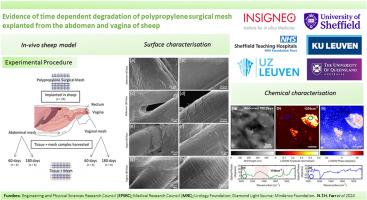从绵羊腹部和阴道取出的聚丙烯手术网片随时间发生降解的证据
IF 3.3
2区 医学
Q2 ENGINEERING, BIOMEDICAL
Journal of the Mechanical Behavior of Biomedical Materials
Pub Date : 2024-09-05
DOI:10.1016/j.jmbbm.2024.106722
引用次数: 0
摘要
聚丙烯网片的失效具有明显的副作用和衰弱特征,这是由多种复杂因素相互作用造成的。其中一个关键因素是聚丙烯(PP)纤维与周围组织之间明显的物理-机械不匹配,从而导致严重的物理损伤、炎症和持续疼痛。然而,人们对聚丙烯本身导致持续炎症的主要原因仍不甚了解。本研究通过多管齐下的综合调查,揭示了假定惰性聚丙烯网片植入绵羊体内的影响。我们采用了先进的传统技术来分析植入 PP 的物理和化学变化。我们的分析表明,植入 60 天后,聚丙烯纤维的表面会发生降解和氧化,180 天后会持续并加剧。植入物周围组织中聚丙烯碎片的出现和积累也随着植入时间的延长而增加。我们展示了纤维表面和硬度的可观察到的物理和机械变化。我们的研究显示,纤维表面的变化表明聚丙烯的化学惰性明显低于最初的推测。这些发现强调了重新评估聚丙烯网植入物的生物相容性和长期后果的必要性。本文章由计算机程序翻译,如有差异,请以英文原文为准。

Evidence of time dependent degradation of polypropylene surgical mesh explanted from the abdomen and vagina of sheep
The failure of polypropylene mesh is marked by significant side effects and debilitation, arising from a complex interplay of factors. One key contributor is the pronounced physico-mechanical mismatch between the polypropylene (PP) fibres and surrounding tissues, resulting in substantial physical damage, inflammation, and persistent pain. However, the primary cause of sustained inflammation due to polypropylene itself remains incompletely understood. This study comprises a comprehensive, multi-pronged investigation to unravel the effects of implantation on a presumed inert PP mesh in sheep. Employing both advanced and conventional techniques to discern the physical and chemical transformations of the implanted PP. Our analyses reveal a surface degradation and oxidation of polypropylene fibres after 60 days implantation, persisting and intensifying at the 180-day mark. The emergence and accumulation of PP debris in the tissue surrounding the implant also increased with implantation time. We demonstrate observable physical and mechanical alterations in the fibre surface and stiffness. Our study shows surface alterations which indicate that PP is evidently less chemically inert than was initially presumed. These findings underscore the need for a re-evaluation of the biocompatibility and long-term consequences of using PP mesh implants.
求助全文
通过发布文献求助,成功后即可免费获取论文全文。
去求助
来源期刊

Journal of the Mechanical Behavior of Biomedical Materials
工程技术-材料科学:生物材料
CiteScore
7.20
自引率
7.70%
发文量
505
审稿时长
46 days
期刊介绍:
The Journal of the Mechanical Behavior of Biomedical Materials is concerned with the mechanical deformation, damage and failure under applied forces, of biological material (at the tissue, cellular and molecular levels) and of biomaterials, i.e. those materials which are designed to mimic or replace biological materials.
The primary focus of the journal is the synthesis of materials science, biology, and medical and dental science. Reports of fundamental scientific investigations are welcome, as are articles concerned with the practical application of materials in medical devices. Both experimental and theoretical work is of interest; theoretical papers will normally include comparison of predictions with experimental data, though we recognize that this may not always be appropriate. The journal also publishes technical notes concerned with emerging experimental or theoretical techniques, letters to the editor and, by invitation, review articles and papers describing existing techniques for the benefit of an interdisciplinary readership.
 求助内容:
求助内容: 应助结果提醒方式:
应助结果提醒方式:


